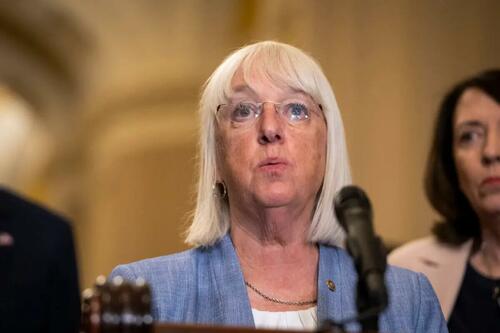Authored by John Haughey via The Epoch Times (emphasis ours),
A day after the Tennessee Valley Authority announced it had filed a permit to install the nation’s first small modular nuclear reactor, Secretary of Energy Chris Wright said the breakthrough marks the dawn of a new era in commercial electrical power and that sustaining momentum in advanced nuclear generation is the nation’s “next Manhattan Project.”
“America must lead the commercialization of affordable and abundant nuclear energy,” he told the Senate Appropriations Committee’s Energy and Water Development Subcommittee. The Department of Energy “is working to advance the rapid deployment of next generation nuclear technology, including small modular reactors.”
Eventually, perhaps within a decade, small nuclear modular nuclear reactors, or SMRs, will be mass-produced, be portable, and ideal for “harnessing our energy potential to power global AI leadership while meeting growing energy demand,” Wright testified, calling commercial deployment of such “next-generation technology … the challenge of our time.”
If so, Democrats and several Republicans wondered during a two-hour May 21 hearing, why is the Trump administration seeking to cut budgets for the department’s Office of Nuclear Energy by nearly 47 percent and its Office of Science by 87 percent in its Fiscal Year ( FY) 2026 spending request?
“On one hand, you and the president say you support U.S. dominance in energy, emerging technologies,” Sen. Patty Murray (D-Wash.) said, “but then, on the other hand, you are proposing cutting over $1 billion dollars in funding to the Office of Science” and $408 million from the Office of Nuclear Energy.
She said the still-vague spending request, a broad outline crafted by the White House’s Office of Management and Budget and not by the department itself, is counterintuitive to the Trump administration’s pledge to “win the AI race against China.”
The previous FY25 Department of Energy budget earmarked $8.6 billion for the Office of Science and nearly $770 million for the Office of Nuclear Energy, key allocations that leverage federal seed money to induce private investment in financing demonstrations of emerging technologies.
The stark slashes in such funding “really undermines critical research programs for AI, for fusion, for quantum computing, for nuclear energy, and critical minerals,” Murray said. “How are investors and companies supposed to have confidence in partnering with you when what you say and what your budget says are two different things?”
Sen. Katie Britt (R-Ala.) asked Wright for assurances that the budget will include funding for SMR development and research into other emerging reactor technologies underway in her state, and Sen. Bill Hagerty (R-Tenn.) stressed how important federal support for commercial nuclear power is for his state and for the nation.
“The United States is at a pivotal moment in energy production. It’s not just for our nation, it’s for the entire world,” Hagerty said. “Tennessee has been at the forefront of what you’ve called yourself ‘the Manhattan Project 2.0.’”
SMRs and emerging nuclear technologies were among an array of topics discussed during the Senate’s first hearing on the Department of Energy’s proposed $45.1 billion budget, which cuts $19.3 billion in funding for Biden Era “green energy” initiatives, including slashing three-quarters of approved allocations for energy efficiency and renewable energy programs, which didn’t include nuclear power options.
The tentative request is 9.4 percent less than FY25’s $52 billion department budget. Beyond a 25-percent increase in funding for the National Nuclear Security Administration, which manages the nation’s nuclear weapons programs, it trims spending by 18.2 percent, cutting $15.2 billion in allocations from the 2021 Bipartisan Infrastructure Law and $2.6 billion from the Office of Energy Efficiency and Renewable Energy.
The “green energy” cuts were telegraphed by President Donald Trump during his campaign and in his executive orders but the massive rollbacks in energy innovation investments are surprising, Murray said.
“It feels like you want to gift-wrap the future and hand it to China,” she told Wright.
More Money Coming
Wright assured senators that the administration will not cripple research and development of SMRs and other emerging technologies by pulling money from ongoing demonstration programs.
He said his department is reshuffling allocations from Biden era “intermittent” energy programs, such as solar and wind, and reorganizing its offices and staffing to be more focused on advancing technologies that will triple the nation’s electrical capacity in the coming decades.
Wright acknowledged the department has not yet finalized its formal spending request, cautioning that in its tentative state, “Each individual line item does not indicate a policy.”
“The nuclear industry is quite enthusiastic and quite confident they’re going to have the best environment ever for commercial nuclear power under this administration,” he said. “What we’re doing is mobilizing tens of billions of dollars of private capital using the government” allocations to anchor those investments.
Wright said the department has offered land near or at its 16 national labs. “We’ve had tons of solicitations to come build on our land,” he said.
Britt said that communist China has “at least 28 nuclear reactors that are in construction, which is about half of the construction of all nuclear reactors across the entire globe,” so time is of the essence.
Wright said that deregulation and permitting reform are top priorities in ensuring that the United States will meet that challenge.
“China is moving full speed ahead with nuclear. In fact, the most reactors they’re building [are], essentially, a knockoff, a stealing of American reactor technology,” he said. “But they build them much cheaper and much faster, and they don’t have the giant bureaucratic regulatory overhang we have in the United States.”

Under current regulations, Wright said, New York’s Grand Central Station “could not be licensed as a nuclear reactor because its radiation is too high.”
The department’s pitch to commercial providers is, “We‘ll be fast, we’ll be efficient. We‘ll help you get going. We’ll arrange creative incentives for you to build nuclear reactors in our space. I think we’ll do it.”
Hagerty asked how the department can be play “a central role in advancing and achieving American energy dominance and grid liability” by advancing SMRs at commercial scale.
Wright said it is prudent to be careful when investing in “first-mover” prototypes to ensure that taxpayer money is wisely spent on systems that will work.
“I am all-in with you on advancing nuclear,” he told Hagerty, and offered an analogy to illustrate why patience is needed while the department restructures loan programs away from renewables to nuclear and other baseload generation.
“Imagine if the Department of Defense sent out a quote to the defense companies, and said, ‘We want to buy tanks. We’ll pay full price for high-performance tanks, but you can deliver a tank that only moves some of the time, maybe when the sun’s shining, and will shoot, maybe, when the wind’s blowing,’” Wright said of intermittent power generators.
The Biden administration was paying full price for “an underperforming tank” while providing subsidies to the factories to build them, he said.
“So what do you think is going to happen?” Wright asked. “You’re going to get paid to deliver an inferior tank and a subsidy. Of course, you’re going to do it.
“And then what happens to your army? It’s not just the poor kids that are in those tanks, it’s the kids that are in all the other tanks that now have underperforming partners in the battle that are at risk.”
Loading…



















